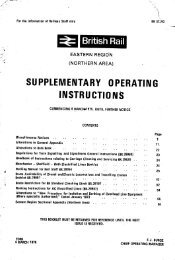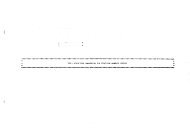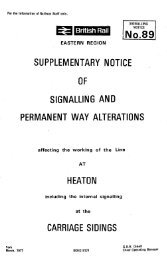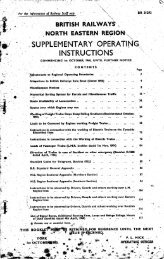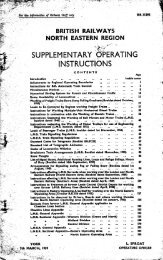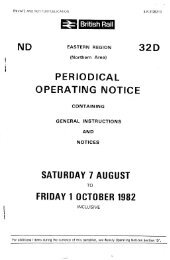general instructions. - Limit Of Shunt
general instructions. - Limit Of Shunt
general instructions. - Limit Of Shunt
Create successful ePaper yourself
Turn your PDF publications into a flip-book with our unique Google optimized e-Paper software.
184 G e n e r a l Instructions.—Continued.<br />
FIRES OCCURRING IN CONNECTION WITH THE CONVEYANCE OF<br />
ACIDS, MATCHES, CHARCOAL, ETC.<br />
General Rules 226 and 279.<br />
The following <strong>instructions</strong> must be observed in dealing with FIRES in<br />
connection -<br />
with<br />
t h e<br />
Fires in Wagons (General).<br />
c Isolate o n vthe<br />
wagon at once and forward it as quickly as possible to the<br />
enearest y awater n supply or Fire Station, unless it is clear that the fire can be<br />
dealt with by buckets of water from the locomotive tender or by smothering<br />
cwith e ballast. After a fire, the wagon must be detained under observation<br />
oat<br />
the nearest Station for a sufficient time to make sure that no further out-<br />
f break of fire will occur.<br />
A Where c any smouldering goods are left at the side of the line, the Station-<br />
i<br />
master<br />
d<br />
at the nearest Station must be notified, and he must take steps to<br />
have the goods, after extinction of any remaining fire, removed to his<br />
s Station , without delay.<br />
MWhen a possible, packages on fire should be removed from the wagons<br />
tbefore cextinguishing,<br />
so as to avoid damaging more goods than necessary<br />
h<br />
with water.<br />
e<br />
s ,<br />
Acids.<br />
C When h consignments of acid are on fire, care must be taken to apply water-<br />
afrom a r safe distance, as the contact of water may cause some dangerous<br />
spurting of the acid.<br />
c o<br />
Sand or earth may be used to stop a fire started by acid, but in that<br />
acase water l should be used soon afterwards to prevent the fire breaking out<br />
, again. Sufficient water must be used to flush away all acid which has been<br />
espilt.<br />
t It is dangerous to breathe acid fumes ; keep, therefore, to the windward,<br />
cand<br />
avoid entering enclosed spaces where such fumes are present.<br />
. Oleum (Fuming Sulphuric Acid) gives off fumes like white smoke, and<br />
may therefore sometimes appear to be on fire if a vessel containing it is<br />
broken or leaking. Do not assume fire in this case unless flame can be seen.<br />
For putting out a fire, ashes, lime or ballast is much better than water in<br />
this case, owing to the heat given out when water comes into contact with<br />
the acid. Avoid getting any acid on the hands or clothes.<br />
In cases where Oleum is leaking from a drum or glass vessel, and the<br />
containing vessel is not broken, the package should either be carefully lifted<br />
out of the wagon and deposited on the ground in a safe place until it can<br />
be attended to by some authorised person, or, if the leak can be temporarily<br />
closed with a wooden plug and the vessel securely scotched in the wagon, it,<br />
should be surrounded with ashes or lime and sent forward to destination.<br />
Celluloid and Celluloid Scrap.<br />
These fires rapidly become fierce so should be dealt with promptly. Water<br />
is the . best extinguisher, but chemical extinguishers may be useful. Such<br />
fires cannot be extinguished by smothering, and therefor. ballast, etc., is<br />
of no use in putting out such fires.






